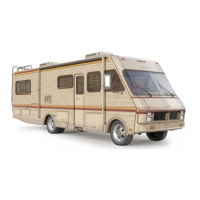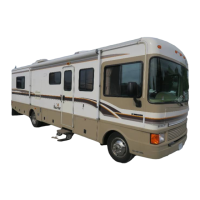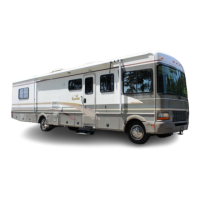Do you have a question about the Fleetwood Bounder 1993 and is the answer not in the manual?
Details the manufacturer's warranty coverage for the motor home's systems and components.
Outlines the owner's obligations for maintenance and reporting defects to ensure warranty validity.
Lists items and conditions not covered by the express warranty, including abuse and normal wear.
Explains the motor home's warranty program, rights, and obligations of owner, dealer, and manufacturer.
Details on the federal certification tag, including GVWR, GAWR, VIN, and vehicle type.
Explains how to use the auxiliary start system to start the engine if the chassis battery is discharged.
Instructions for operating the heater and air conditioner, including fan speed and air direction.
Details on the optional generator start switch and its operation.
Guidance on motor home loading, GVWR, GAWR, and avoiding overloading for safety and warranty.
Explanation of how to determine and manage the motor home's carrying capacity.
Tips for proper loading to ensure even weight distribution and safe handling.
Steps for weighing the motor home to ensure it is within Gross Axle Weight Ratings (GAWR) and GVWR.
Information on maintaining proper tire inflation, replacement guidelines, and handling flat tires.
Recommendations for choosing hitches and trailers, and limits for towing vehicles with your motor home.
Importance of seat belts for all occupants, including instructions for child restraint systems.
Guidance on driving characteristics, parking maneuvers, and handling different road conditions.
Details on fuel types, refueling safety, and preventing vapor lock in gasoline-powered models.
Discussion of general chassis operations, including engine fan behavior.
Critical safety information about carbon monoxide poisoning and detector operation.
Approved methods and preparations for emergency towing of the motor home.
Guidelines for attaching accessories to the motor home, considering structural integrity and warranty.
Instructions for operating the hydraulic leveling system; do not use as a jack.
Information on operating entry doors, screens, and various types of windows.
Guidance on maximizing storage space, securing items, and protecting contents from weather.
Tips for organizing and securing items in interior storage areas like closets and cabinets.
Details on converting dinette and sofa areas into beds and care for interior furnishings.
Operation of interior lighting and overhead vents for ventilation and air circulation.
How to read the monitor panel for fresh water, grey water, black water tanks, and battery condition.
Discusses the impact of extended occupancy on interior finishes and the need for ventilation.
Methods to reduce interior condensation during cold weather, including ventilation strategies.
Safety measures against fire hazards, including extinguisher use and smoke detector maintenance.
Information on connecting to city water and using the on-board fresh water storage tank.
Procedures for filling the fresh water tank from city connection or exterior fill spout.
Operation of the 12-volt DC water pump and maintenance of the inline water filter.
Common water system problems, including leaks, and how to avoid them through maintenance.
Steps for sanitizing the fresh water tank and piping using a chlorine solution.
Description of the waste water system, including grey and black water holding tanks.
Procedures for draining holding tanks, proper hookups, and tank care to prevent clogging.
Overview of the vehicle's electrical system, including battery, charging, and lighting.
Details on the 12-volt system powering lights, outlets, and accessories, including battery care.
Guidelines for inspecting, cleaning, and maintaining the vehicle's batteries.
Information on operating the 120-volt system for appliances, connecting to external power.
Explanation of GFI outlets for electrical shock protection and testing procedures.
Location and function of 120-volt circuit breakers and 12-volt fuses for circuit protection.
Instructions for operating the generator safely, including fuel supply and ventilation requirements.
Essential safety precautions for handling, lighting, and using LP gas appliances.
Description of key LP gas system components like hoses, regulator, and their functions.
Considerations for using LP gas systems in cold weather and managing fuel availability.
Procedure for safely filling the chassis-mounted LP gas tank at a service station.
Methods for checking the LP gas system for leaks using soap solution or leak detection solution.
How the permanently installed LP gas leak detector works and how to test it.
Instructions for lighting various LP gas appliances, including pilot lights and burners.
Details on operating the LP gas water heater and ensuring it is filled with water before lighting.
Proper operation of the refrigerator, emphasizing the need for a level surface.
Instructions for operating the LP gas furnace, including thermostat settings and airflow.
Guidance on operating the optional roof-mounted air conditioner and its power consumption.
Information on powering entertainment equipment like VCRs and TVs from 12-volt or 120-volt sources.
Tips for improving TV and radio reception, addressing issues like ghosts and FM flutter.
Procedures for washing, waxing, and cleaning the motor home's exterior fiberglass finish.
Instructions for inspecting and resealing exterior joints, windows, and roof components.
Guidance on cleaning interior surfaces, including upholstery, drapes, and paneling.
An overview of the comprehensive maintenance checklist for various components and intervals.
Checklist of steps for preparing the motor home for short-term storage (less than 60 days).
Steps for preparing the motor home for long-term storage (over 60 days), including battery and fuel care.
General winterization procedures for equipment and systems to prevent damage during cold weather.
Detailed steps for winterizing the RV water system using antifreeze to prevent freezing.
Procedure to safely reactivate the motor home after a period of storage, including checks and fluid top-ups.
Details the manufacturer's warranty coverage for the motor home's systems and components.
Outlines the owner's obligations for maintenance and reporting defects to ensure warranty validity.
Lists items and conditions not covered by the express warranty, including abuse and normal wear.
Explains the motor home's warranty program, rights, and obligations of owner, dealer, and manufacturer.
Details on the federal certification tag, including GVWR, GAWR, VIN, and vehicle type.
Explains how to use the auxiliary start system to start the engine if the chassis battery is discharged.
Instructions for operating the heater and air conditioner, including fan speed and air direction.
Details on the optional generator start switch and its operation.
Guidance on motor home loading, GVWR, GAWR, and avoiding overloading for safety and warranty.
Explanation of how to determine and manage the motor home's carrying capacity.
Tips for proper loading to ensure even weight distribution and safe handling.
Steps for weighing the motor home to ensure it is within Gross Axle Weight Ratings (GAWR) and GVWR.
Information on maintaining proper tire inflation, replacement guidelines, and handling flat tires.
Recommendations for choosing hitches and trailers, and limits for towing vehicles with your motor home.
Importance of seat belts for all occupants, including instructions for child restraint systems.
Guidance on driving characteristics, parking maneuvers, and handling different road conditions.
Details on fuel types, refueling safety, and preventing vapor lock in gasoline-powered models.
Discussion of general chassis operations, including engine fan behavior.
Critical safety information about carbon monoxide poisoning and detector operation.
Approved methods and preparations for emergency towing of the motor home.
Guidelines for attaching accessories to the motor home, considering structural integrity and warranty.
Instructions for operating the hydraulic leveling system; do not use as a jack.
Information on operating entry doors, screens, and various types of windows.
Guidance on maximizing storage space, securing items, and protecting contents from weather.
Tips for organizing and securing items in interior storage areas like closets and cabinets.
Details on converting dinette and sofa areas into beds and care for interior furnishings.
Operation of interior lighting and overhead vents for ventilation and air circulation.
How to read the monitor panel for fresh water, grey water, black water tanks, and battery condition.
Discusses the impact of extended occupancy on interior finishes and the need for ventilation.
Methods to reduce interior condensation during cold weather, including ventilation strategies.
Safety measures against fire hazards, including extinguisher use and smoke detector maintenance.
Information on connecting to city water and using the on-board fresh water storage tank.
Procedures for filling the fresh water tank from city connection or exterior fill spout.
Operation of the 12-volt DC water pump and maintenance of the inline water filter.
Common water system problems, including leaks, and how to avoid them through maintenance.
Steps for sanitizing the fresh water tank and piping using a chlorine solution.
Description of the waste water system, including grey and black water holding tanks.
Procedures for draining holding tanks, proper hookups, and tank care to prevent clogging.
Overview of the vehicle's electrical system, including battery, charging, and lighting.
Details on the 12-volt system powering lights, outlets, and accessories, including battery care.
Guidelines for inspecting, cleaning, and maintaining the vehicle's batteries.
Information on operating the 120-volt system for appliances, connecting to external power.
Explanation of GFI outlets for electrical shock protection and testing procedures.
Location and function of 120-volt circuit breakers and 12-volt fuses for circuit protection.
Instructions for operating the generator safely, including fuel supply and ventilation requirements.
Essential safety precautions for handling, lighting, and using LP gas appliances.
Description of key LP gas system components like hoses, regulator, and their functions.
Considerations for using LP gas systems in cold weather and managing fuel availability.
Procedure for safely filling the chassis-mounted LP gas tank at a service station.
Methods for checking the LP gas system for leaks using soap solution or leak detection solution.
How the permanently installed LP gas leak detector works and how to test it.
Instructions for lighting various LP gas appliances, including pilot lights and burners.
Details on operating the LP gas water heater and ensuring it is filled with water before lighting.
Proper operation of the refrigerator, emphasizing the need for a level surface.
Instructions for operating the LP gas furnace, including thermostat settings and airflow.
Guidance on operating the optional roof-mounted air conditioner and its power consumption.
Information on powering entertainment equipment like VCRs and TVs from 12-volt or 120-volt sources.
Tips for improving TV and radio reception, addressing issues like ghosts and FM flutter.
Procedures for washing, waxing, and cleaning the motor home's exterior fiberglass finish.
Instructions for inspecting and resealing exterior joints, windows, and roof components.
Guidance on cleaning interior surfaces, including upholstery, drapes, and paneling.
An overview of the comprehensive maintenance checklist for various components and intervals.
Checklist of steps for preparing the motor home for short-term storage (less than 60 days).
Steps for preparing the motor home for long-term storage (over 60 days), including battery and fuel care.
General winterization procedures for equipment and systems to prevent damage during cold weather.
Detailed steps for winterizing the RV water system using antifreeze to prevent freezing.
Procedure to safely reactivate the motor home after a period of storage, including checks and fluid top-ups.
| Brand | Fleetwood |
|---|---|
| Model | Bounder 1993 |
| Category | Motorhomes |
| Language | English |











